Services on Demand
article
Indicators
Share
Cuadernos de neuropsicología
On-line version ISSN 0718-4123
Cuad. neuropsicol. vol.4 no.2 Santiago 2010
ORIGINAL PAPERS
Neuropsychological performance in a sample of institutionalized chronic schizophrenic patients.
Desempenho neuropsicológico em uma amostra de pacientes esquizofrênicos cronicamente institucionalizados.
Desempeño neuropsicológico en una muestra de pacientes esquizofrénicos institucionalizados.
Luis Maia1
ABSTRACT
We study the results of a descriptive and exploratory study, with the intent to understand the results of a 21 male schizophrenic patients interned in a Portuguese Mental Health Care Centre, evaluated with neuropsychological test. We tried also to link these tests with variables such as schooling, family contact or lengh of internment. The assessment instruments were: Digits Series and Vocabulary Task, both from WAIS, Raven Progressive Matrices, Rey's Complex Figures, Luria's Series Neuropsychological Screening, Clock Task - Neuropsychological Screening and Visual Search and Attention Test. Results show that there is not an attention deficit clinically significant, even that data suggests light attention affection; also variables like family contact and schooling appear as protective factors of memory and also seems to be important for the planning / organization functions.
Keywords: Schizophrenia, Neuropsychiatry, Neuropsychology, Psychological assessment, WAIS, Raven Progressive Matrices, Rey's Complex Figures, Luria's Series Neuropsychological Screening, Clock Task - Neuropsychological Screening
RESUMO
Avaliámos os resultados de um estudo exploratório e descritivo, com o intuito de entender os resultados de 21 pacientes esquizofrénicos masculinos internados num centro português de cuidados de saúde mental, avaliados com testes neuropsicológicos. Procurámos relacionar estes testes com variáveis como escolaridade, contacto familiar ou duração do internamento. Os instrumentos de avaliação foram: Série de dígitos e vocabulário da WAIS, Matrizes progressivas de Raven, Figura Complexa de Rey, Séries gráficas neuropsicológicas de screening de Luria, Teste do Relógio e Teste de busca visual e atenção. Os resultados dos testes sugerem que não se verifica um défice de atenção clinicamente significativo, mesmo que os dados sugiram ligeira disfunção; variáveis como contacto familiar e escolaridade aparecem também como factores protectores da memória e parecem também ser importantes para o panejamento / funções executivas cerebrais.
Palavras-chaves: Esquizofrenia, Neuropsiquiatria, Neuropsicologia, avaliação psicológica, WAIS, Matrizes Progressivas de Raven, Figura Complexa de Rey, Séries de screening neuropsicológico de Luria, Teste de screening do Relógio
RESUMEN
Se analizan los resultados de un estudio descriptivo y exploratorio, con el propósito de comprender los resultados de 21 pacientes esquizofrenicos varones, evaluados con pruebas neuropsicológicas, internados en un centro portugués de salud mental. Se busca relacionar estas pruebas a variables tales como escolaridad, contacto familiar o duración de la internación. Los instrumentos del evaluación fueron: serie de dígitos y vocabulario del WAIS, las matrices progresivas de Raven, las figuras complejas de Rey, La serie gráfica neuropsicológica del screening de Luria, el Test del reloj y el test de búsqueda visual y atención. Los resultados de las pruebas sugieren que no hay un déficit de atención clínicamente significativo, aunque sugieren un defecto ligero de la atención. Las variables como contacto familiar y escolaridad aparecen como los factores protectores de memoria y también parecen ser significativos para las funciones de ejecutivas del cerebro como son la planificación y organización.
Palabras clave: Esquizofrenia, Neuropsiquiatria, neuropsicología, evaluación psicológica, WAIS, Matrices Progresivas de Raven, Figura Compleja de Rey, Screening neuropsicológico de Luria, Test del Reloj
Based in our experience with psychotic and particularly schizophrenic patients, the idea that the lack and slowing of cognitive and affective experience showed in the majority of psychiatric diseases, is usually contrasted with what we call the "particular schizophrenic mind": a mind disturbed by undesired realities, as a result of a summation process of abnormal experiences (Maia, 2002). The well known differentiation of "positive" and "negative" symptoms proposed by Crow (1980), allowed a body of investigation on how schizophrenia could be characterized as a disease of several faces, as well stressed about its heterogeneous classification (Cohen & Docherty, 2005; Bruno, 2005).
Since the works of Siedman, schizophrenia has been characterized as a neurobehavioral pathology (Siedman, 1983, 1990; Siedman, Cassens, Kremen & Pepple, 1992; Kremen, Seidman, Pepple, Lyons, Tsuang & Faraone, 1994). As reminded by Heaton, Gladsjo, Palmer, Kuck, Marcotte & Jeste (2001) a large prevalence of neuropsychological deficits in schizophrenic patients are well documented, varying from mild deficits to frank dementia.
Several different types of neuropsychological deficits as been pointed out: Kraepelin (1896) & Bleuler (1911) (In Monteiro & Louzã, 2007) already stated a deficit in social skills, reading, attention, making choices, keeping thought track, amongst others. Alterations in memory, intellectual quotient, attention, language and executive functions have been also reported (Fioravanti, Carlone, Vitale, Cinti & Clare, 2005). Some authors propose a clear relation between the executive functions deficits (related with malfunction of frontal lobes) and poor critical, which in extreme condition could be characterised as anosognosia, available by a plethora of neuropsychological tests (Kasapis, Amadro, Yale, Strauss & Gorman, 1995; Lysaker & Bell, 1997; Marks, Fastenau, Lysaker & Bond, 2000). That is why we want to know the performance of a group of patients diagnosed with schizophrenia in a series of neuropsychological instruments and relate this performance to social variables such as education, family contact and duration of hospitalization
METHODOLOGY
In our clinical sample, we study the results of a descriptive study yielding an exploratory approach, with the intent to understand the results of a given sample of schizophrenic patients, when presented to a established variety of neuro psychological tests, and how their performance oscillate when we consider the variables of the study. The sample is constituted by 21 male schizophrenic patients, interned in a Portuguese Mental Health Care Centre, with the diagnosis of Schizophrenia Paranoid Type (DSMIV, 1995). The assessment instruments were: Digits Series and Vocabulary Task, both from WAIS (Almeida, 1996), Raven Progressive Matrices (Simões, 1994), Rey's Complex Figures (Edipsico, 1995), Luria's Series Neuropsychological Screening (Luria, 1973), Clock Task - Neuropsychological Screening (Royall, Mulroy, Chiodo & Polk, 1999) and Visual Search and Attention Test (VSAT - Trenerry, Crosson, DeBoe & Leber - 1990). We do not choose a battery of only neuropsychological tests evaluation, but a set of tests of some batteries that we believe to be robust enough to measure the specific dimensions.
SAMPLE
Sample was 21 patients. All subjects had ages between 35 and 50 years of age, all where male, and had an history of internment not superior to 15 years (average years of internment is 12 years, and the mean for social contact or having a visit from a relative or friend is one contact every three months).
The principal characteristics of the sample are described in Table I and II. Ages varies from 34 years (minimum) and 50 years (maximum); the majority of subjects are between 34 to 40 years of age (52.4%). The majority is not married (61.9 %), 3 are married (14.3%), 1 is divorced (4.8%) e 1 is widow (4.8%). The majority has not sons (66.7%); 5 admitted to have t least on son (23.8%) and 2 do not wanted to reveal (9.5%) (Table I). The subjects present low levels of official academic instruction (Table II); we have 42.9% (9 subjects) with four years in school; two subjects (9.5%) attended 6 years in school, and 3 subjects (14.3%) concluded 9 years.
From the 4 subjects that attended high school, only 1 has graduated (4.8%). Two subjects (9.6%) were inscribed in College education (with no conclusion) and 1 subject (4.8%) does not have any academic education.
Regarding to profession before institutionalization, 47.6% (10 subjects) presented a professional active life. To the rest of patients, hospital records don't allow to perceive if and what the profession that patient had before to get sick (Table II).

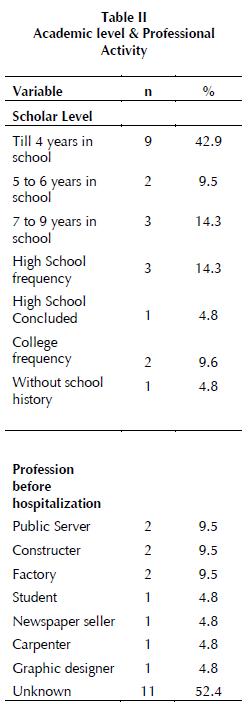
INSTRUMENTS
Digits Series from Wechsler Adult Intelligence Scale (WAIS) – immediate memory is measured by the quantity of evoked digits in the right order (forward and backward); Vocabulary from WAIS: verbal memory is measured by the quantity of correct definitions when confronted with particular words; Raven Progressive Matrices: visual and spatial coordination functions from the executive cognitive machinery; Rey's Complex Figures: access perceptive activity (in copy) where the subject has to organize the reproduction of a set of complex stimulus parting for a given visual model - visual memory is evaluated by the ability to reproduce the original sample of Rey's figure; Luria's Series Neuropsychological Screening: assess operative cognitive functions (executive frontal functions); Clock Drawing Task - Neuropsychological Screening: assess operative cognitive functions (executive frontal functions); Visual Search and Attention Test (VSAT): assess attention levels in conditions of distractive evaluation.
PROCEDURE
Data were collected in the mental hospital after being guaranteed the informed consent (patients were chosen by their clinical reports and the assistant doctor assured all the introduction, contact and evaluation process, realized by us - Luis Maia).
To all subjects where explained the objectives of the process and the possibility to leave the process at any time. As one of the major exclusion criteria, patients should not be in an active psychotic break up.
RESULTS
Results have been divided in two sections, beginning with the specifics performances to address the overall results. First we present the test results and, secondly, the dimensions results (Attention, cognitive structure, memory)
RESULTS IN TERMS OF TESTS
The results have been organized according to each of the tests used in order to facilitate understanding.
REY'S COMPLEX FIGURE
Rey-Osterieth Complex figure test is generally accepted as one of the most widely utilized neuropsychological tests in order to evaluate visual spatial construction along with nonverbal memory skills, not only in clinical patients and also in normal populations (Shin, Kim, Cho & Kim, 2003). In general, 38% of the patient's present have normal results. The summation of these data with the performance of the patients in Rey Complex Figure, where 80,9% had reached results equal or inferior to percentile 30 (notice that 42,9% of the total are placed below of percentile 10); as well as 19.1% was not capable of realize the test at all, having alleged incapacity to organize the stimulus.
In Figure I we can see Rey reproduction performance of a 69 years old patient, with a very low academic level (one year in school). Also, this patient has been institutionalized for about 30 years in a psychiatric hospital yard. As we can see, the reproduction is characterised by a reduction to a familiar scheme, and we can also find a rotation effect, which facilitate the reduction to a familiar scheme. We can also see that the draw is very poor and even with concrete – child characteristics.
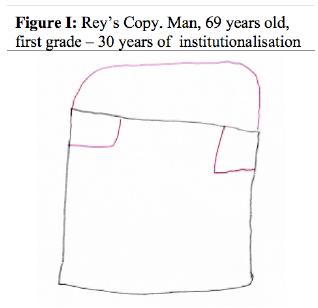
Just for curiosity it is interesting to note that, after the accomplishment of the entire test (copy and memory), the patient was asked about what he have drawn. He firmly stated that he only done what we have asked him to do "...I've only copy this drawn...". Even with the model in front of him, in order to compare the model and its reproduction, the subject continues stating that "...The draw is fine!! There is nothing wrong with it!...".
This characteristic is very common in this type of patients, that seems to present lack of insight and anosognosia (a condition in which a patient, after suffered a given brain dysfunction, seems unacquainted or denies the existence of a deficit): this type of deficit makes most of the patients present more erroneous answers, although with a higher level of certainty when compared with other clinically impaired subjects.
We can observe a very similar process in Figure II, although in a very opposite side. As we can see, the reproduction is characterised by a reduction to a familiar scheme, and we can also find a rotation effect, which facilitate the reduction to a familiar scheme. Nonetheless, this time, the picture is very rich in details (is almost impossible do not recognize a fish-like or a rocket-like figure). That is to say: these patients, seems to incorporate their own reality and reproduced an internal schema from internal cognitive schemes, more than just copied a model, as they were asked to do. The difference is must probably at levels of variables that differentiate the two schizophrenic patients. The first one is very old, with very low education and interned for almost an eternity; the second one is 39 years old, reaches the fourth grade and has been institutionalised "only" by the last 13 years. We can postulate that the youngest patient is not so mentally deteriorated and, by that, his mind is more characterized by what we call the undesired realities in schizophrenia.
This pattern seems to gain some strength when we analyze carefully the performance of subject represented in figures V-VI, a 48 years old schizophrenic patient, and third grade in school with 15 years of institutionalisation in a psychiatric yard.
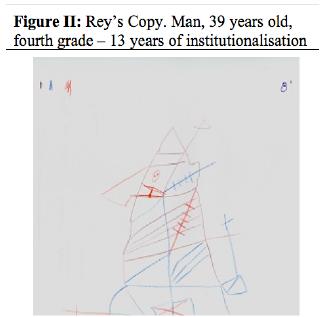
The analysis of figure III & IV allow us to put on the table another particular characteristic of some patients. Sometimes, the fact that in the reproduction phase in the Rey Copy, some patients do it very well, do not assure a good performance in memory phase. In figure III we can observe the reproduction by copy of a 37 year old patient, fourth grade, and with 15 years of institutionalization. Nonetheless, only after three minutes, his ability to recall the required information is almost inexistent (Figure IV). As we will discuss later, again, sometimes, a good capacity to reproduce a complex set of stimulus by copy do not assure that the ability to reproduce them by memory is maintained.
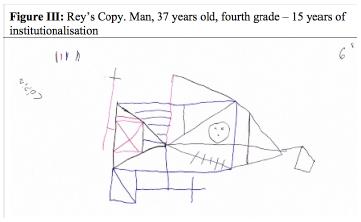
The example showed in figure VI represents the memory performance of a paranoid schizophrenic patient. Pay attention in strong distortion regarding the original model (already noted in the copy process – Figure V). It clearly seems that if in the copy process, the patient already presented a strong difficulty to maintain the copy product accurately, in the memory task, he presents a clear confabulation; or what some authors denominate as knowledge corruption (Moritz & Woodward, 2006). This term is related with an aberration in meta-memory, when patients embrace false information with tough certainty. According to Moritz & Woodward (2006), this abnormality in meta-memory is thought to stem from poor memory accurateness in concurrence with impaired discrimination of correct and incorrect judgments in terms of assurance and could contribute, if we establish a bridge with psychiatric clinical reality, to the emergence of delusions and according to Garety & Freeman (1999), aberrations in logical thinking.
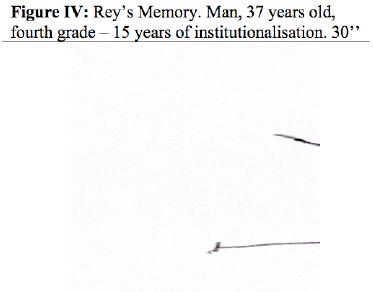
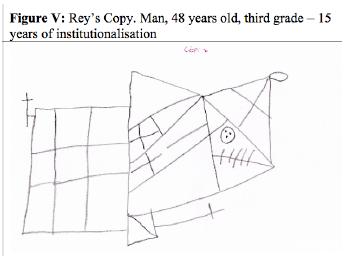
LURIA'S GRAPHIC AND DIGITS SERIES
These tasks evaluate high cognitive executive functions ("pre-frontal tasks") at the level of stimulus organization (e.g. select a goal, planning, monitoring, evaluate, etc.); attentional deficits, bradiprhenia (that may be related with pharmacotherapy, obsessive and perfectionist styles, etc.) as well as perseverations (Maia, 2002).
As will be discussed further, performance in Luria Graphic series is characterized by some particular nuances. In figure VII (note that is the same patient in figure I) we see that our 69 old patient presents the same pattern of reducing the task to reproducing a familiar schema (Again, it seems very plausible to state that the subject forgot the instruction - "please, copy this pattern till the end of the page").
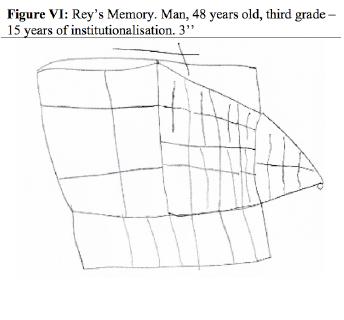
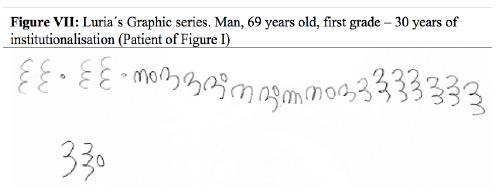
In figure VIII we can observe a slight attentional deficit and in the Figure IX we can observe a more sever signal, called perseveration.

CLOCK DRAWING TEST
The use of Clock drawing test has been proposed as a good screening test in several neuropsychiatric disorder, and particularly in schizophrenia (Bozikas, Kosmidis, Gamvrula, Hatzigeorgiadou, Kourtis, Karavatos, 2004), not only in inpatients but also in patients not institutionalized.
As stated by Shulman (2000), the clock-drawing test meets clear criteria for a cognitive screening tool. It taps into a broad variety of cognitive abilities as well as executive functions, is fast and simple to administer and score with tremendous acceptability by subjects, and according with the author "...the clock-drawing test is complementary to the widely used and validated Mini-Mental State Examination and should provide a significant advance in the early detection of dementia and in monitoring cognitive change..." (p. 548).

Although we didn't find any statistical significant differences to demonstrate that, concerning to the accomplishment of the clock drawing test, it is verified that the majority of citizens (42, 9%; N = 9) presents results clearly disorganized and 19% (N = 4) presented medium disorganized results. In the next figures presented we can see that our patients tends to have a strong difficulty in organize the stimulus in the proper clock site (Figure X) and sometimes the performance is really disorganized Figure XI.
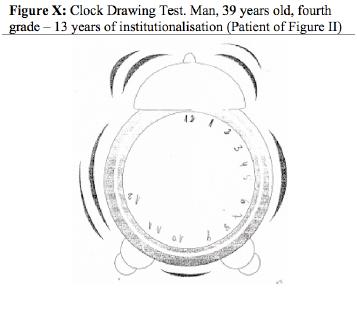
In a study carried by Heink, Vainer- Benaiah, Lahav & Drummer (1997), were they evaluated the performance of long-term institutionalized elderly schizophrenics showing that the clock drawing skills of a significant section of these patients were impaired, and they concluded that these results should be attributed not only to cognitive deficits but also to non-cognitive (psychiatric state) factors and time of disease.
In another study with 21 elderly schizophrenic patients ('graduates') and 21 Alzheimer Disease patients matched for gender and education, and cognitive impairment confirmed by a Folstein mini-mental state examination (MMSE) score of 18-23 (Heinik, Lahav, Drummer, Vainer- Benaiah & Lin, 2000), even though schizophrenic patients and Alzheimer Disease patients had similar total scores on the clock drawing test, they differed on specific test items related to spatial/planning deficit and preservation. These types of errors are very common in patients with affection of frontal lobes, as seems to be the case of Schizophrenic patients.
Particularly related with slowness and inattention deficits in performance in Clock Drawing were presented as related with negative symptomatology in schizophrenia (Kim, Jun, Kwon, Jeong, Hwang & Shim, 2007).
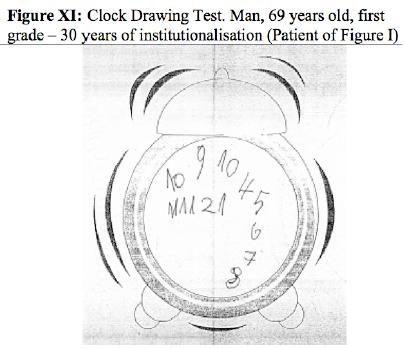
VISUAL SEARCH AND ATTENTION TEST
In this test, we can found several characteristics of Stroop effect, being the general errors usually related with a reply conflict, error of reply, or selective attention (Lezak, Howieson & Loring, 2004). In fact, on VSAT, 100% of the subjects meet below percentile 6; more specifically, 90.47% meet in percentile 1.
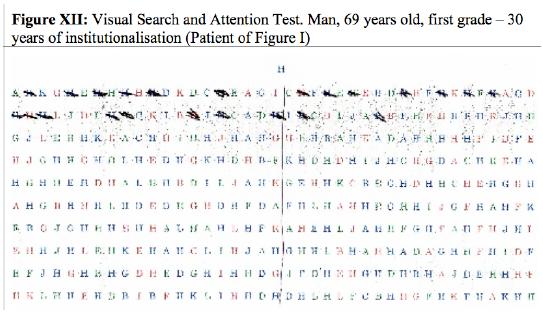
However, will or not be able to exist another factor, that not attentional deficit, behind of such low results with a so high incidence in this sample?
As we can see in the figure bellow (XII), the patient completed few stimulus (23) and committed 5 errors.
Woodward, Whitman, Arbuthnott, Kragelj, Lyons & Stip (2005) presents the idea that could support these findings in VSAT. They state that the study of visual search speed in schizophrenic patients has established that when more than one object's characteristics are displayed so that the subject could evaluate the entire picture, amongst some distracters, then the search speeds would be increased with the number of distracter items. At the same time, in the last decades a dysfunction of eye tracking, an oculomotor reaction created by visual movement signals have been strongly suggested as being in the bases of visual difficulties and, as stated by Chen, Bidwell & Holzman (2006) and Chen, Bidwell & Norton (2006), not simply in schizophrenic patients but also in their relatives.
Obviously, considering the age of this patient (69), as well as the long history of institutionalisation (30 years), the conjugation of these two factors (age and visual functions) could play a role in these typical deficits in schizophrenic patients, as proposed by Bidwell, Holzman & Chen (2006).
Raven TestResults in the Raven test were 100% below the percentile 25 and allow us to accept that, in this sample of patients, the organization/planning capacities (pre-frontal activity), are clearly misfunctional.
RESULTS REGARDING THE COMPARISON OF EVALUATIONS
Of the related statistical analyses, is not evidenced any significant results that show that subjects who have lower results in VSAT are also the ones that presents malfunction of attention in the Digits (U= 37.00; p = 0,28). In the same way, it was not found statistics significance differences between the results of the inverse Digit-order and the Luriaattention (U= 38.00; p = 0,297). We found a strong correlation (>.90) between the times of accomplishment of the Rey Complex Figure (Copy) and Matrices of Raven
RESULTS IN TERMS OF MAJOR DIMENSIONS ASSESSED
Attention deficits in this schizophrenic patients sample In terms of VSAT frequencies, separated by categories, all patients are below percentile 6, compared with normal aged subjects.
We observed that 90.47% (19 subjects) are in percentile 1. We cannot find negative relation between VSAT and social Contact (r= .22; p = .33). According to attention deficits measured by Luria's Series, we cannot again find any significant relationship with social contact (U = 49.5; p =. 85). We do not find any relationship between VSAT and Scholar level obtained in the exterior of the hospital (α2 = 4.99; df. = 3; p = .17). Also, we do not find any relationship between VSAT and Scholar level obtained in the interior of the hospital (U =28.5; p = .20).
The differences found in the VSAT and bradiprhenia in Luria's Series shows that the patients that presents lower results in VSAT also presents bradiprhenia in Luria's Series (U = 4.00; p = .021). When we compare the time spent in the resolution of VSAT and Luria's Series, we do not find any significant statistical difference (U = 18.50; p = .39). Subjects that present less bradiprhenia in Luria's Series are the one that spend more time in Rey's copy (U = 3.00; p = .02). The same is for Rey's Memory (U = 3.00; p = .02). The same relation is verifiable regarding Luria's Series and Raven Progressive Matrices (U = 7.00; p = .04).
DEFICITS IN COGNITIVE STRUCTURE FUNCTIONS IN THIS SCHIZOPHRENIC PATIENTS SAMPLE
In the CDT there are no statistical differences considering the three possible forms to characterize its realization ("good/normal" – n=8, 38 %; "mildly disorganized" – n=4, 19%; and "clearly disorganized" – n=9, 42.9% - α2 = 1.33; df. = 2; p =.51).
In Rey's copy task we found that 42,9% present results inferior to percentile 10; 14.3% are in percentile 30; 5 subjects (23,8%) where not able to accomplish the task due to strong difficulties in organize and trace a plan to star the task. Only 3 subjects (14.3%) achieved results superior to percentile 80.
Subjects that obtain medium levels in the ability to present planification and cognitive structure (CDT, Rey's copy, etc.) presents greater social contact (α2= 8.504; df. = 2; p = .014). We do not found any relation in Rey's copy task and levels of Social Contact (r = .27; p = .22). We do not found any relation in Rey's copy task and external scholar activity (α2 = 4.32; df = 3; p = .22). We do not found any relation in Clock drawing and internal scholar activity (U = 39; p = .638). Subjects that spend more time in Raven Matrices also presents better results in the Raven and Rey's copy task. In Rey's copy, those who spend more time achieve better accomplishment in this task. Digits were not related with VSAT, and time of institutionalization.
MEMORY DEFICITS IN THIS SCHIZOPHRENIC PATIENTS SAMPLE
In Digits task almost half of the patients presented results bellow the average (47.6%, n=10). Of all subjects 38 % (8 subjects) are in normal range and 14.8% (3 subjects) are above the average. In Vocabulary task 57.1% of patients (12) presented results bellow the average, and the rest of patients are inside the average range (42.9%; n = 9).
The correlations between Digits, Vocabulary and Social contact were all lower than p = .01 (positive significant correlation).
We found the same tendency when consider the Digits – WAIS results and social contact (r = .620; p = .01). In Rey's memory task, only 5 subjects (23.8%) where not able to finish it. From the rest (71.2%), only 2 subjects presented results in percentile 50 and 70. All other subjects scores in / or above percentile 10 (62%). Rey's memory task is not statistically correlated either with Digits or Vocabulary tasks from WAIS.
We also verify that patients with higher levels of academic education presents better results in Rey's memory task (α2 = 9.279; df = 3; p = .026). There are no significant correlations between total time of institutionalization and any other task related with this function.
DISCUSSION
In this study we looked for to understand if the deficit in the capacity of structuring of high cognitive operations were presented with a bigger incidence how much lesser it was the contact with the family. Regarding to the results, these are presented of difficult understanding: in fact, significant differences exist between the structuring/planning ability measurable for CDT, and the amount of socio-familiar contact.
We can accept the hypothesis that, being the variable of total social contact an important and determinative variable in the results gotten to the level of the planning/structuring of the higher operative functions, this relation is not linear at all, that is, we can not say that the bigger is the social contact, the better will be the results of subjects in the related test.
However, we can affirm that, the lowest levels of social contact (till 10 days in the last 3 years) correspond to unstructured levels of the related skill of planning and cognitive structuring; and, if we consider the two other groups of results jointly, we can verify that subjects that present levels of social contact that goes of 21 to 75 days in the last three years, are those that presents medium or good/normal results in this skill. All the other variables considered in this analysis: social contact (compared with the Rey-copy), exterior scholarship4 (Clock and Rey-copy) and internal scholarship (Clock and Rey-copy), do not demonstrate significant differences, for what, in this sample, it is not to foresee that they are determinative for the biggest capacity of functional structuring to the level of the planning/organization of prefrontal functions.
In this study we also inquire if we could identify clinically significant deficits in attention in the schizophrenic patients of the sample. A first analysis could lead to accept this hypothesis. In fact, on VSAT, 100% of the subjects meet below percentile 6; more specifically, 90.47% meet in percentile 1. However, will or not be able to exist another factor, that not attentional deficit, behind of such low results with a so high incidence in this sample?
In schizophrenic patients, in what respects the low performances in tests that require psycho-motor activity, the secondary effect of medication (essentially neuroleptics, Mata, Pérez-Nievas, Beperet & Psicost Group, 2000) have been presented as eventual causes for this exactly low income (Palmer, Heaton & Jest, 1999). There are indications that neuroleptics could provoke accented motor slowing, having as base the dysfunction of cerebral areas on the base of initiative taking (Casey, 1995). In the same way, motor abnormalities are frequent in Schizophrenia and can be supported by the malfunctions of the striatum or basal ganglia (Sullivan, Fama, Shear, Cahn-Weiner, Stein, Zipursky & Pfefferbaun, 2001).
Thus, in the anticipation of the necessity to skirt these effect of the neuroleptic as explanation for eventual results, we looked to use instruments where at least one of them did not measure attention from a test where the motor accomplishment of a given task were necessary, trying to neutralize the effect of the motor slowing in the result of the tests.
So, beyond the VSAT (a specific test of measurement of the attention) and of the Luria series, both requiring graphical accomplishment, we also used the digit series from WAIS, whose evocation of the series in inverse sequence not only implies immediate memory as well as the maintenance of the related series in the field of the attention, assuring the absence of the graphical accomplishment component. Thus, it would be interesting to compare the accomplishment in the inverse order of the digits with the VSAT, and still with the Luria-attention.
Once normative data is not given for the Portuguese population, we considered solely the inverse order of the series of digits, with implication of the attention, mattering then to look to correlations between this subtest and the accomplishment in the VSAT and the Luria-attention.
Of the related statistical analyses, is not evidenced any significant results that show that subjects who have lower results in VSAT are also the ones that presents malfunction of attention in the Digits (U= 37.00; p = 0,28); this would be a strong argument in favour of the clarifying paper of the attentional deficit based on low results in VSAT (once the digits do not involve the graphical accomplishment, not being, therefore, expectable to suffer a process from "motor" slowing, as stated before).
In the same way, it was not found statistics significance differences between the results of the inverse Digit-order and the Luria-attention (U= 38.00; p = 0,297) in such a way that we could say that subjects with attentional deficit in the Luria task, were also the ones that had worse results in the inverse Digit-order. According to interpretative manual of VSAT (Trenerry, Crosson, DeBoe, Leber, 1990), if the low performance is verified in subjects that give few errors or any at all, as is the case of the subjects of this sample (which makes that they fill few lines in the test), is most likely that the same is due to bradiphrenia and not for attentional deficit, once that in this last malfunction we meet a standard accomplishment different from the ones found on this sample: that is, subjects with attentional deficit tend to fill many lines with many errors, provoked clearly for the attenttional deficit itself.
The fact that we found a strong correlation between the times of accomplishment of the Rey Complex Figure (Copy) and Matrices of Raven, with the results found in the same ones, reflect exactly this slowing process, that is, the subjects that spend more time are the ones that have better results, that allow us to estimate that if, as in the VSAT, the subjects were forced to accomplish a given time, the results would be clearly inferior, for the limitation of time (would be interesting to attribute a limited time of accomplishment, as the used for normal population: T score for time = 10).
Making, however, a more qualitative analysis of the results, it is verified that the performance of the subjects in the Luria Series, the Digits Series presents results that suggest a slight attentional compromise. In fact, in the series of digits in inverse sequence (Backwards), only 5 subjects (23,8%) obtain average, results even though they have not standardized notes, corresponding to make right half of the digits in the series in 9 possible digits.
Also in the Luria Graphic Series, the attentional error seems not to be related with the graphical accomplishment properly said, but to the fact of the patient can not keep in the attentional field the rule that states that, after drawing the two stimulus with given characteristics, must initiate other given different stimulus, coming back to draw the others two previous stimulus. These subjects change the stimulus; however they do not respect the rule of quantity (2+1+2+1, etc.).However, it seems most coherent reject the hypothesis of finding a clinically significant attentional deficit in this sample of schizophrenic patients, once the low results in the VSAT can better be explained by the slowing in the graphical execution, being this, very probably result of the neuroleptic medication. However, conjointly, the data of the study leave to foresee a certain attentional deficit, being these results in accord with Comvit et al., 2001, that demonstrates malfunctions of prefrontal lobes in schizophrenic patients, in studies of cerebral imagiology, even tough the statistical results do not allow, by itself, support the hypothesis formulated in the direction of attention deficit as a category of diagnosis in the DSM-IV.
Data analysis of this study allows us to state that, in this specific sample of schizophrenic patients, there is a clear malfunction of mnesic skills. Thus, in each one of the three tests where the memory is directly measured, the majority of the patients present results clearly below the average compared with normal population data. However, the very low results in the reproduction for memory in Rey Complex Figure, have, in part, to be understood as precipitated for the great amount of patients that, yet at the copy moment (abnormal codification of the stimulus) had a very compromised performance, thus influencing the reproduction for memory. The fact of finding a strong positive correlation between results of the Vocabulary Test (verbal memory) and Digits (immediate recall memory) come to strengthen de compromised mnesic functions in these patients.
These results are in accord with an important study of Aleman, Hijman, Haan & Kahn (1999), which carried through a meta-analysis of 70 studies that demonstrate to exist memory deficit, either of long term or short term in schizophrenic patients. According to authors this deficit of memory would be exactly independent of the age, medication, duration of the illness, social status of the patient, severity of the pathology or presence of positive symptoms (see Elvevbag, Weinberg & Goldberg, 2001; Hill, Ragland, Gur & Gur, 2001).
To this respect, the attribution of the joined deficits to the direct collateral effect of the neuroleptic medicine must be evaluated in a careful way, once several investigations (Cassens, Inglis, Appelbaum, & Gutheil, 1990) suggest that the effect of neuroleptic medication may progress in two directions: some aspects of the motor capacities (that could explain the slowing verified in the accomplishment of the tests that involve graphical execution) and monitoring skills can be affected adversely, but other aspects, as the resolution of problems and the attention can be optimized or to stay unchanged. Thus it seems verifiable that in this sample of schizophrenic, memory, as a whole, appears to be affected.
When related the data in the different used tests of memory we verify that, for example, the total time of sociofamiliar contact in the last the 3 years is clearly correlated with the results in the Digit Series. In the same way, the level of scholarship previous to the last internment also seems to be determinant in the results gotten in the task of the memory in Rey complex figure, where the highest indices of scholarship correspond to higher results in Rey memory task.
Thus, the level of pertaining to school activity and the contact with the family/society during the internment, seem to be, in this specific sample of schizophrenic patients, protection factors for dysfunction in this skills. At the same time, being the memory a very sensible skill to the effect of training, the fact of the subjects with higher levels of academic experience, seems to produce better performances in memory tasks, demonstrating the importance of developing programs of occupation and maintenance of the most possible active life, even in situations of long internment. Lubow, Kaplan, Abramovich, Rudnick & Laor (2000), developed a study were a visual search task was used to evaluate attentional function in a varied grouping of schizophrenic patients and in normal controls. Subjects have to identify the presence or absence of a single character obtainable from consistent distracters. The Response Time (RT) was examined as a function of preceding practice with target, distracter, or both. On each trial, targets and/or distracters were either original or recognizable, and the schizophrenic patients showed a slower performance than controls in all conditions. The authors state that these results propose that the Latent Inhibition effect is in reality associated to the processing of extraneous stimulus, and that schizophrenic patient's process it differently when compared to controls.
Lee & Cheunga (2005), showed in a study where they examined if subjects with schizophrenia give us an idea about visual-perceptual difficulty and whether singular mechanism of attention, namely sustained attention, selective attention, switching attention and attentional control processing, relate to the visual-perceptual function of patients with schizophrenia. Amongst other tasks they used the Hooper Visual Organization Test with 47 patients diagnosed with schizophrenia and 47 normal controls. The results corroborate the strong difficulties in patients when compared with controls in the referred above variables.
Other strong evidence in schizophrenic patients is the maintenance of great confidence in its performance although it could be completely inaccurate, in a phenomenon known as overconfidence regarding false memory attributions (Moritz, Woodward & Ruff, 2003). Furthermore, some studies support the idea that firstepisode patients reveal cognitive impairments comparable to those of patients with an established schizophrenia disease (e.g. Addington & Addington, 2002).
At this point of the clinical knowledge is well accepted that working memory deficits in schizophrenia could play an important role in the localization of underlying neurologic impairment and in the explanations of incongruent cognitive deficits associated with this disorder (Goldman-Rakic & Selemon, 1997). The same, and in conformity with our clinical data, as well as in well documented and replicated sources, other studies suggest spatial working memory deficits in schizophrenia (McDowell & Clementz, 1996).
Broerse, Holthausen,Van Den Bosc & Den Boer (2001), stressed the necessity to comprehend the usual idea of impaired frontal function in schizophrenia. They stated that neuropsychological studies demonstrate marked and diverse frontal deficits although some studies found normal cognitive function in a proportion of patients. They used saccadic tasks as a known index of frontal function, and examined the presence of frontal deficits in patients either with neuropsychological or saccadic tasks, comparing the sensitivity of both procedures for frontal deficits. Twenty-four (24) schizophrenic patients and twenty (20) healthy controls completed an extensive neuropsychological battery and three saccadic tasks. Considering neuropsychological battery alone, 42% of the patients presented frontal deficits, but when combined the use of neuropsychological and saccadic tasks this resulted in 79% with frontal deficits.
Despite some particular conclusions of this study, this type of works allow us to consider the relevance of frontal lobes not only in the frontal neuropsychological deficits showed by our schizophrenic patients but also the importance of saccadic eye movements and its role in poor visual-spatial performances in tasks as Clock drawing, VSTA, Luria's Graphic Series and Rey complex Figure. The relation between performance on the gap task and worth of flat search and its relevance for a prefrontal insufficiency proposition of schizophrenia has also been discussed (Sereno & Holzman, 1993).
All this type of deficits discussed above could strongly contribute for the so called "Everyday Actions in Schizophrenia" as stated by Kessler, Giovannetti & MacMullen (2007). Royall, Chiodo & Polk (2000) states that Executive Control Functions (measured by several cognitive tasks, like clock drawing test in 561 subjects), has statistically major effects on intensity of care and Instrumental Activities of Daily Life impairment, even among non institutionalized retirees. The problem is that this developing disability could be not well detected by traditional global cognitive procedures and by that, the evaluation and treatment may be delayed unless Executive Control Functions measures are employed (Royall, Chiodo & Polk, 2000).
In fact, the Neuropsychiatric and Neuropsychological semiologic reality could not be separated from its impact in everyday manifestations of schizophrenic patients, and have to be considered not only in its treatment but particularly by those who live directly with this struggling reality.
A particular deficit in motility in schizophrenia is the blocking of voluntary action, or ambitendency, as classified by Portnoff, Golden, Snyder & Gustavson (1982). These authors stress that this could be explained by a psychomotor slowing due to a neurologic pathogenesis, particularly due to the malfunctions and disconnections between left frontal cortex and by that, could be correlated with cortico-motor slowing of the dominant hand.
As in previous studies in Portugal with Luria Nebraska Neuropsychological Battery - LNNB (Maia, Loureiro & Silva, 2002), this test was utilized but, at this time, with a modified version of the Motor Scale of the LNNB and the Finger Tapping Test of the Halstead-Reitan Neuropsychological Battery – the test were administered to 10 chronic undifferentiated schizophrenics, 10 paranoid schizophrenics, 10 patients with major depressive disorders, 10 patients with mixed personality disorders, and 10 normal subjects (Portnoff, Golden, Snyder & Gustavson, 1982). The major conclusions of this studied were: a) 5"both chronic schizophrenics and major depressives demonstrated a significant frequency of ideokinetic apraxia in comparison with the other groups. b) age was found to correlate positively with ideokinetic apraxia in the depressives, suggesting that such symptoms may be an artifact of the aging process in these subjects. c) Ideokinetic apraxia was correlated with slowing of the dominant hand in the chronic schizophrenics, suggesting a neurologic rather than a psychologic basis for their blocking of voluntary action. d) no group demonstrated a significant incidence of ideational apraxia" .pp. 39
Regarding to these results, schizophrenic patients tends to present strongly impaired results not only in copy but also in recall process, as reinforced y others (Seidman, Lanca, Kremem, Pharaone & Tsuang, 2003). Responding to some genuine doubts, they state that these results are independents of IQ levels, antipsychotic medication dosage, time of institutionalization and so fort. As suggested by the majority of clinical researchers they state that these deficits represent a genuine impairment in visual memory, visual organizational processing retention difficulties and decomposition of visual organizational and memorial processes.
There is no doubt at this point by the clinical knowledge that a remarkable deficit in memory in schizophrenic patients is clearly available (Aleman Hijman, de Haan & Kahn, 1999), not being necessarily related with a normalized level of intellectual performance and diverse cognitive functions (Saykin, Gur, Gur, Mozley, Mozley, Resnick et al. 1991; McKenna, Tamlyn, Lund, Mortimer, Hammond & Baddeley, 1990) allowing us to state that in the enormous memory process, a large diversity of phenomenon are involved.
According to recent studies of Vaskinn, Finset, Agartz, Barrett, Faerden, Simonsen, et al. (2009), their studies investigates the alliance linking apathy and neurocognitive performance in patients with first episode psychosis, with the hypothesis that apathy is more connected with tests representative of executive function than tests demonstrating other neuro-cognitive domains.
Mohamed, Paulsen, ÓLeary, Arndt & Andreasen (1999) defends that, in concordance with several past studies, major cognitive impairment transversely to several skill domains are a central part quality of schizophrenia and is not caused by persistent disease, treatment, or institutionalization.
In schizophrenic patients with executive dysfunction as part of mild delirium, perseveration processes usually occurs (Levenson, Collins & Puram, 2005) being the patients insensitive to perceive the deficit presented. The relative commonly prevalence in general population in a lifetime expectation, is of 1%, and makes it a relatively common neuropsychiatric disorder (Andreasen, 1995).
The visual selective attention among persons with schizophrenia in a presence of distracters was studied by Elahipanah, Christensen & Reingold (2008) trying to test the hypotheses that impair visual attention amongst patients with schizophrenia can be accounted by poor perceptual organization and impaired search selectivity. So, they studied 23 patients with schizophrenia and 22 healthy control subjects that concluded a conjunctive visual search task where the relative frequencies of two types of distracters were manipulated. As results they found that, when the total number of items in a display is fixed, search performance depends on the relative frequency of the types of distracters (for example, as the ratio becomes more discrepant search time decreases). The major suggestion of this paper, according to the authors is that patients with schizophrenia, group items according to their perceptual similarity and flexibly deploy their attention to the smaller subset of distracters on each trial.
Generally speaking, in agreement with previous works of Kolb and colleagues (1983) & Silverstein and colleagues (1998) (quoted by Goder, Boigs, Braun, Friege, Fritzer, Aldenho & Hinze-Selch, 2004), schizophrenic patients did not strongly differ on copy condition of Rey - figure, although usually presents poorer results on recall condition, when compared to healthy controls.
Analyzing in detail the work of Silverstein: Rey-Osterrieth Complex Figure Test Performance in Acute, Chronic, and Remitted Schizophrenia Patients (Silverstein, Osborn & Palumbo, 1998) we find their interest in study the assessment in "visual memory disturbance in different forms of schizophrenia" (p. 987), comparing Rey-Osterrieth Complex Figure Test (RCF) performance in intensely psychotic, persistently psychotic, and outpatient schizophrenia patients and in a control group of acutely psychotic patients with other different form of schizophrenia. The major conclusions were that no group differences were found on the copy process.
Gooding & Braun (2004) proposed that visual hemi-spatial inattention has to be better understood to explain poorer results in schizophrenic patients when compared to normal. For that, they realized a study about visual constructive performance and hemispatial inattention in schizotypic college students and control subjects using the Rey–Osterrieth Complex Figure Test (CFT). Copy and delay CFT accuracy, plus line bisection scores on the CFT, were equally examined in right-handed males presenting positive schizotypy (deviantly high scorers on the Perceptual Aberration and Magical Ideation Scales; n= 24) and individuals reporting negative schizotypy (deviantly high scorers on the revised Social Anhedonia Scale and Physical Anhedonia Scale; n= 26), as well as controls (n= 45). According with their results, the negative schizotypy group displayed reduced visual constructive performance, as calculated by performance on both copy and delay trials of the CFT. The authors did not found a significant relationship between schizotypy and hemi-spatial inattention, assuming, by those results, that negative schizotypy could be associated with memory performance deficits, but do not necessarily supports prior assertions of a relationship between hemispatial inattention and positive schizotypy.
The relevance of Rey Osterieth Complex figure was again well pointed out in another study carried by Lysaker, Lancastaer, Nees & Davis (2003); was examined if levels of emotional suffering and impairments in visual memory were exclusively associated with severity of delusions in schizophrenia. They accessed severity of delusions using selected items from the positive component of the Positive and Negative Syndrome Scale among patients with schizophrenia or schizoaffective disorder in a post-acute phase of illness, emotional distress was accessed with the neuroticism subscale of the NEO PI-R five factor and visual memory was accessed using the Rey Complex Figure Test controlling for executive function, visual attention, and verbal memory. The authors concluded that severity of delusions was linked to both higher levels of neuroticism and greater impairment in visual memory.
As stated by Bozikas, Kosmidis, Gamvrula, Hatzigeorgiadou, Kourtis & Karavatos (2004), related with which sub-type of Clock Drawing Test (CDT) known, the fact that the CDT is "sensitive enough to detect the cognitive impairment inherent in schizophrenia, as well as being correlated with symptom severity makes this test useful in roughly assessing cognitive state in schizophrenia. Its simplicity and brevity are two distinct advantages of its use in every day clinical practice. Moreover, even though the five clock conditions provide different types of clinical information, if only one condition can be administered, the 'free drawn' clock should be selected, as it contains all the elements of the clock drawing task" (p. 236).
Davenport, Sponheim & Stanwyck (2006) states that "Schizophrenia patients and their unaffected firstdegree relatives exhibit performance deficits on attention tasks, perhaps indicating genetic influence over attentional abnormalities in schizophrenia. To identify anomalous brain function associated with attention in individuals who likely have unexpressed genetically ability for schizophrenia, we studied electrophysiological characteristics of unaffected siblings of schizophrenia patients during a visual serial search task. We gathered behavioural and electrophysiological data from 19 schizophrenia patients, 18 unaffected biological siblings of schizophrenia patients, and 19 no psychiatric control participants during performance of the Span of Apprehension (Span) task and a control task. Schizophrenia patients had lower Span task accuracy than the other two groups. Schizophrenia and sibling groups exhibited diminished late positive potentials (P300) over parietal brain regions during Span trials. Compared to control task stimuli, attentional demands of Span stimuli elicited augmented early negative potentials (N1, P2) over posterior brain regions. The degree of augmentation was reduced in schizophrenia patients but not in siblings compared to control subjects. Unaffected siblings of schizophrenia patients appear to modulate early attentional functions of posterior brain regions more effectively than schizophrenia patients but show later electrophysiological anomalies suggestive of abnormal up dating of task-relevant information. While the latter may reflect neural mechanisms predisposing performance deficits on attentional tasks, the former may reflect compensatory processes presenting unaffected relatives of schizophrenia patients (p.16) ".
Heinik, Lahav, Drummer, Vainer & Druthlin (2000) CDT may, as a result, be an attractive instrument for the detection of degenerative-dementia in persistently institutionalized aged schizophrenics. Heinik, Vainer- Benaiah, Lahav & Drummer (1997), once most of these studies don't take in consideration any control or comparison group ("e.g late-onset schizophrenics, non-institutionalized community-based schizophrenics, non-schizophrenic institutionalized patients", p. 655), the conclusions about the possible relationship between duration of illness, chronic institutionalization and clock drawing skills seem premature if not framed into a more integrative conceptualization picture.
CONCLUSIONS
According to Goldman-Rakic (1991), "findings of impaired memory are now well established in schizophrenia. More studies are needed, however, that attempt to place memory dysfunction within the context of the developmental course of schizophrenia. Specifically, the relationship of short-term recall dysfunction to both working memory and long-term memory needs to be clarified". In addition, according to Silverstein, Osborn & Palumbo (1998) the role that memory impairment plays in social dysfunction and adaptive functioning, in general, in preschizophrenic subjects has been largely unexplored. Previous data (Kern, Green & Satz, 1992) point towards that memory dysfunction is related with reduced skill acquirement in behaviour therapy amongst patients with schizophrenia supplementary advance of protecting therapy for subjects at risk for schizophrenia, as well as rehabilitative therapies for patients recovering from psychotic episodes, awaits further defined explanation of memory impairment in this disease. These advances, as stated by Silverstein, Osborn & Palumbo (1998) will be possible when we better understand the ways in which memory dysfunction(s) limits adaptive coping skills, and the ways in which reduced coping skills and increased stress levels produce symptoms and further disorganization of memory and other cognitive systems.
The accomplishment of our study presented here allowed us to study some of the questions related with the neuro psychological manifestations in the schizophrenia when related with beginning, course and quality of the interactions / experiences of life of the schizophrenic patients.
Of all the analysis carried in this study does not seem to have clinically significant attentional deficit in the sample of the study, even though the results suggests a light atrentional dysfunction; in accordance with previous studies (Aleman et al., 1999), it seems to indicate the existence of a clear deficit of some neuropsychological skills, as are the case of memory and functions related with planning capacity of pre-frontal lobes under several given stimulus (Cf. Concept of hipo-frontality, Ingvar & Franzen, 1974).
The level of pertaining to school activity and the contact with family during the internment, appear as protective factors of memory being that, the maintenance of the sociofamiliar contact also seems to be important for the planning / organization functions to the level of the high cognitive operative functions. Thus, being the memory a very sensible skill to the training of daily life events, the development of programs of effective and applied occupation in a rationalized and directed form (through Ergotherapia, maintenance of scholarship during the long internment, program of occupation of free times, etc.) seems to be a protection factor against the normal process of reduction of these abilities in the process of long internment (Abaurrea et al., 2000; Maia, 2002).
By all the exposed, some efforts should have to be developed to delay the process of Institutionalization (Rosenham, 1984) from which the sick person of long internment goes, gradually spoiling. Another great conclusions that we can remove of this study is that perhaps it is not the amount of internments or duration of the same ones that produces a greater or minor deterioration of the general state of the subjects, namely having the neuropsychological variables in cause, but yes the quality of the internment that determines the acceleration, slowing, or even inversion of this deterioration process that Goffman (In Watslawick, 1979) classified as a slowing deterioration process, in some cases, eventually, in direction to death.
REFERENCES
Abaurrea, P., Astrain, M.V., Elgorriaga, G., Litago, R. & Lora, B. (2000). Necesidades sociales de los enfermos esquizofrénicos en Navarra. Anales del Sistema Sanitario de Navarra, 23 (Supl. 1), 95-99. [ Links ]
Addington, J. & Addington, D. (2002). Cognitive functioning in first-episode schizophrenia. Journal of Psychiatry & Neuroscience. 27(3 May), 188–192.
Aleman, A., Hijman, R., de Haan, E.H. & Kahn, R.S. (1999). Memory impairment in schizophrenia: A meta analysis. American Journal of Psychiatry. 156, 1358–1366.
Almeida, L (1996). Escala de inteligência de Wechsler para adultos III [teste] / David Wechsler. Lisboa : CEGOC : TEA, 1996. [ Links ]
Andreasen, N.C. (1995). Symptoms, signs, and diagnosis of schizophrenia. Lancet. 346, 477-481. [ Links ]
Bidwell, L.C., Holzman, P.S. & Chen, Y. (2006). Aging and visual motion discrimination in normal adults and schizophrenia patients. Psychiatry Research. 145, 1–8.
Bozikas, V.P., Kosmidis, M.H., Gamvrula, K., Hatzigeorgiadou, M., Kourtis A., Karavatos, A. (2004). Clock drawing test in patients with schizophrenia. Psychiatry Research.121, 229-238. [ Links ]
Broerse, A., Holthausen, E.A.E., van den Bosch, R.J. & den Boer, J.A. (2001). Does frontal normality exist in schizophrenia? A saccadic eye movement study. Psychiatry Research. 103, 167-178. [ Links ]
Bruno, R. (2005). Relationships between the Symptomatology and Neuropsychology of Schizophrenia: Three, Five, Eleven, or a Greater Number of Valid Syndromes? Thesis submitted in fulfilment of the requirements for the Degree of Doctor of Philosophy (Clinical Psychology). University of Tasmania, September. [ Links ]
Cassens, G., Inglis A.K., Appelbaum, P.S. & Gutheil, T.G. (1990). Neuroleptics: Effects on neuropsychological function in chronic schizophrenic patients. Schizophrenia Bulletin. 16, 477-499. [ Links ]
Chen, Y., Bidwell, L.C & Norton, D. (2006). Trait vs. State Markers for Schizophrenia: Identification and Characterization through Visual Processes. Current Psychiatry Review. 2 (4 November), 431-438. [ Links ]
Chen, Y., Bidwell, L.C. & Holzman, P.S. (2005). Visual motion integration in schizophrenia patients, their first-degree relatives, and patients with bipolar disorder. Schizophrenia Research. 74, 271–281.
Cohen, A.S. & Docherty, N.M. (2005). Symptom-Oriented Versus Syndrome Approaches to Resolving Heterogeneity of Neuropsychological Functioning in Schizophrenia. The Journal of Neuropsychiatry and Clinical Neuroscience. 17 (3, Summer), 384-390. [ Links ]
Comvit, A., Wolf, O.T., de Leon, M.J., Patalinjug, M., Kandil, E., Caraos, C., Scherer, A., Louis, L.A.S. & Cancro, R. (2001). Volumetric analysis of the pre-frontal regions: findings in aging and schizophrenia. Psychiatric Research: Neuroimaging Section. 107, 61-73. [ Links ]
Crow, T. J. (1980). Molecular pathology of schizophrenia: More than one dimension of pathology? British Medical Journal. 280, 66- 68. [ Links ]
Davenport, N.D., Sponheim, S.R. & Stanwyck, J.J. (2006). Neural anomalies during visual search in schizophrenia patients and unaffected siblings of schizophrenia patients. Schizophrenia Research. 82, 15–26.
DSM-IV (1995). Manual Diagnóstico Estatístico de Transtornos Mentais. 4ª Ed. Artes Médicas. [ Links ]
Edipsico (1995). REY - Teste de Cópia de Figuras Complexas. Versão portuguesa. EDIPSICO - Edições e investigação em psicologia, Lda. [ Links ]
Elahipanah, A., Christensen, B.K. & Reingold, E.M. (2008). Visual selective attention among persons with schizophrenia: The distractor ratio effect. Schizophrenia Research. 105, 61-67. [ Links ]
Elvevag, B., Weinberger, D.R. & Goldberg T.E. (2001). Short-term memory for serial order in schizophrenia: a detailed examination of error types. Neuropsychology. 15, 1, 128-135. [ Links ]
Fioravanti, M., Carlone, O., Vitale, B., Cinti, M.E. & Clare, L. (2005). A meta-analysis of cognitive deficits in adults with a diagnosis of schizophrenia. Neuropsychology Review. 15 (2), 73-95. [ Links ]
Garety, P.A. & Freeman, D. (1999). Cognitive approaches to delusions: A critical review of the evidence. British Journal of Clinical Psychology. 38, 113–154.
Goder, R., Boigs, M., Braun, S., Friege, L., Fritzer, G, Aldenho, L.B. & Hinze-Selch, D. (2004). Impairment of visuo spatial memory is associated with decreased slow wave sleep in schizophrenia. Journal of Psychiatric Research. 38, 591-599. [ Links ]
Goldman-Rakic, P.S. & Selemon, L.D. (1997). Functional and anatomical aspects of prefrontal pathology in schizophrenia. Schizophrenia Bullettin. 23, 437–458.
Goldman-Rakic, P.S. (1991). Psychopathology and the Brain (eds) Carroll, B. J. & Barrett, J E.) 1−23. American psychopathology. Ass. & Raven, New York.
Gooding, D.C. & Braun, J.G. (2004). Visuo constructive performance, implicit hemispatial inattention, and schizotypy. Schizophrenia Research. 68, 261–269.
Heaton, R.K. Gladsjo, J.A. Palmer, B.W., Kuck, J., Marcotte, T.D. & Jeste, D.V. (2001). Stability and Course of Neuropsychological Deficits in Schizophrenia. Archives of General Psychiatry.58, 24-32. [ Links ]
Heinik, J., Lahav, D., Drummer, D., Vainer- Benaiah, Z. & Lin, R. (2000). Comparison of a clock drawing test in elderly schizophrenia and Alzheimer's disease patients: a preliminary study. International Journal of Geriatric Psychiatry. 15(7), 638-643. [ Links ]
Heinik, J., Vainer-Benaiah, Z., Lahav, D. & Drummer, D. (1997). Clock drawing test in elderly schizophrenia patients International Journal of Geriatric Psychiatry. 12 (6), 653- 655. [ Links ]
Hill, S.K., Regland, J.D., Gur, R.C. & Gur, R.E. (2001). Neuropsychological differences among empirically derived clinical subtypes of schizophrenia. Neuropsychology. 15 (4), 492-501. [ Links ]
Ingvan, D.H. & Franzen, G. (1974). Distribution of cerebral activity in chronic schizophrenics. Lancet. 7895, 1484-1486. [ Links ]
Kasapis, C., Amadro, X.A., Yale, A.S., Strauss, D.H. & Gorman, J.M. (1995). Poor Insight in Schizophrenia: Neuro psychological and Defensive Aspects. Schizophrenia Research. 15, 123. [ Links ]
Kern, R.S., Green, M.F. & Satz, P. (1992). Neuropsychological predictors of skills training for chronic psychiatric patients. Psychiatry Research. 43, 223-230. [ Links ]
Kessler, R.K., Giovannetti, T. & MacMullen, L.R. (2007). Everyday Action in Schizophrenia: Performance Patterns and Underlying Cognitive Mechanisms. Neuropsychology. 21 (4), 439–447.
Kim, S.Y., Jun, Y.H., Kwon, Y.J., Jeong, H.Y., Hwang, B.Y. & Shim, S.H. (2007). Correlations of Cerebellar Function with Psychotic Symptoms and Cognitive Function in Schizophrenic Patients. Journal of Korean Society of Biological Psychiatry. 14(3 Aug), 184-193. [ Links ]
Kremen, W.S., Seidman, L.J. Pepple, J.R., Lyons, M.J., Tsuang, M.T. & Faraone, S.V. (1994). Neuropsychological Risk Indicators for Schizophrenia: A Review of Family Studies. Schizophrenia Bulletin. 20, (1), 103- 119. [ Links ]
Lee, T.M.C. & Cheunga, P.P.Y. (2005). The relationship between visual-perception and attention in Chinese with schizophrenia. Schizophrenia Research. 72, 185– 193.
Levenson, J.L., Collins, E. & Puram, H. (2005). Images in Psychosomatic Medicine: The Clock-Drawing Test. Psychosomatics. 46 (1 January-February), 77-78. [ Links ]
Lezak, M.D., Howieson, D.B. & Loring, D.W. (2004). Neuropsychological assessment. 4th. Oxford: Oxford University. [ Links ]
Lubow R.E., Kaplan, O., Abramovich, P. Rudnick, A. & Laor, N. (2000). Visual search in schizophrenia: latent inhibition and novel pop-out effects. Schizophrenia research . 45 (1-2), 145-156. [ Links ]
Luria, A.R. (1973). The Working Brain. USA, Basic Books. [ Links ]
Lysaker, P.H. & Bell, M.D. (1997). Impaired Insight in Schizophrenia. In: X.F. Amador, & A.S. DAVID (eds.): Insight in Psychosis. Oxford University Press, New York. 307- 316. [ Links ]
Lysaker, P.H., Lancastaer, R.S., Nees, M.A. & Davis, L.W. (2003). Neuroticism and visual memory impairments as predictors of the severity of delusions in schizophrenia. Psychiatry Research. 119, 287-292. [ Links ]
Maia, L. (2002). Neuropsychological Disfunctions in Schizophrenic Patients. Revista Psicologia e Educação. 1 (Dez. 1-2), 51-72. [ Links ]
Maia, L.A., Loureiro, M.J., Silva, C.F. (2002). Versão Portuguesa Experimental da Bateria Neuropsicológica de Luria-Nebraska (Adaptada e traduzida de Golden, Hammeke & Purisch, 1982, sob autorização), Universidade da Beira Interior. [ Links ]
Marks, K.A., Fastenau, P.S., Lysaker, P.H. & Bond, G.R. (2000). Self-Appraisal Questionaire (SAIQ): Relationship to Researcher-Rated Insight and Neurpsychological Function in Schizophrenia. Schizophrenia Research. 45, 203-11. [ Links ]
Mata, I., Pérez-Nievas, F., Beperet, M. & grupo Psicost. (2000). Evolución de los patrones de tratamento de los pacientes esquizofrénicos. Anales de los sistemas Sanitários de Navarra. 23, Supl. 1, 73-82. [ Links ]
McDowell, J.E. & Clementz, B.A. (1996). Ocular-motor delayed response task performance among schizophrenia patients. Neuropsychobiology. 34, 67–71.
McKenna, P.J., Tamlyn, D., Lund, C.E., Mortimer, A.M., Hammond, S. & Baddeley, A. D. (1990). Amnesic syndrome in schizophrenia. Psychological Medicine. 20, 967–972.
Mohamed, S., Paulsen, J.S., ÓLeary, DO., Arndt, S. & Andreasen, A. (1999). Generalized Cognitive Deficits in Schizophrenia: A Study of First-Episode Patients. Archives of General Psychiatry. 56, 749-754. [ Links ]
Monteiro, L.C. & Louzã, M.R. (2007). Cognitive deficits in schizophrenia: functional consequences and therapeutic approaches. Revista de Psiquiatria Clínica. 34 (Supl. 2), 179-183. [ Links ]
Moritz, S. & Woodward, T.S. (2006). The Contribution of Metamemory Deficits to Schizophrenia. Journal of Abnormal Psychology. 15 (1), 15–25.
Moritz, S., Woodward, T.S. & Ruff, C.C. (2003). Source monitoring and memory confidence in schizophrenia. Psychological Medicine. 33, 131-139. [ Links ]
Palmer, B.W., Heaton, R.K. & Jeste, D.V. (1999). Extrapyramidal symptoms and Neuropsychological Deficits in Schizophrenia. Biological Psychiatry. 45, 791-794. [ Links ]
Portnoff, L.A., Golden, C.J., Snyder, T.J. & Gustavson, J.L. (1982). Deficits of Ideokinetic Praxis in Chronic Schizophrenics on A Modified Version of the Luria-Nebraska Motor Scale. International Journal of Neuroscience. 16 (3-4), 151-158. [ Links ]
Rosenham, D.L. (1984). On Being San in Insane Places. In: P. Watzlawick (ed). The Invented Reality. New York: 117-144. [ Links ]
Royall, D.R., Chiodo, L.K. & Polk, M.J. (2000). Correlates of Disability Among Elderly Retirees With "Subclinical" Cognitive Impairment. The Journals of Gerontology Series A: Biological Sciences and Medical Sciences. 55, M541-M546. [ Links ]
Royall, D.R., Mulroy, A.R., Chiodo, L.K. & Polk, M.J. (1999). Clock drawing is sensitive to executive control: A comparison of six methods. Journal of Gerontology. 54B(5), P328-P333. [ Links ]
Saykin, A.J., Gur, R.C., Gur, R.E., Mozley, P.D., Mozley, L.H., Resnick, S.M. et al. (1991). Neuropsychological function in schizophrenia: Selective impairment in memory and learning. Archives of General Psychiatry. 48, 618–624.
Seidman, L.J. (1983). Schizophrenia and brain dysfunction: An integration of recent neurodiagnostic findings. Psychological Bulletin. 94, 195-238. [ Links ]
Seidman, L.J. (1990). The neuropsychology of schizophrenia: A neurodevelopmental and case study approach. Journal of Neuropsychiatry and Clinical Neuroscience. 2, 301-312. [ Links ]
Seidman, L.J., Cassens, G., Kremen, W.S. & Pepple, J.R. (1992). The neuropsychology of schizophrenia. In: R.F. White, (ed.) Clinical Syndromes in Adult Neuropsychology: The Practitioner's Handbook. Amsterdam, The Netherlands: Elsevier. 381-450. [ Links ]
Seidman, L.J., Lanca, M. Kremem, W.S., Pharaone, S.V. & Tsuang, M.T. (2003). Organizational and visual memory deficits in schizophrenia and Bipolar Disorders using the Rey-Osterrieth Complex Figure. Effects of duration of Ilness. Journal of Clinical and experimental Neuropsychology. 5 (7), 949- 964. [ Links ]
Sereno, A.B. & Holzman, P.S. (1993). Express Saccades and Smooth Pursuit Eye Movement Function in Schizophrenic, Affective Disorder, and Normal Subjects. Journal of Cognitive Neuroscience. 5 (3 Summer), 303-316. [ Links ]
Shin, M-S., Kim, Y-H., Cho, S-C. & Kim, BN. (2003). Neuropsychological Characteristics of Children With Attention- Deficit Hyperactivity Disorder (ADHD), Learning Disorder, and Tic Disorder on the Rey-Osterreith Complex Figure. Journal of Child Neurology. 18 (12), 835-844. [ Links ]
Shulman, K. (2000). Clock Drawing: is the ideal cognitive screening test? International Journal of Geriatric Psychiatry. 15, 548-561. [ Links ]
Silverstein, S.M., Osborn, L.M. & Palumbo, D.R. (1998). Rey-Osterrieth Complex Figure Test Performance in Acute, Chronic, and Remitted Schizophrenia Patients. Journal of Clinical Psychology. 54 (7 Nov), 985-994. [ Links ]
Simões, M. (1994). Investigações no âmbito da aferição nacional do teste das Matrizes Progressivas de Raven (M.P.C.R.). Dissertação de Doutoramento apresentada à Faculdade de Psicologia e Ciências da Educação da Universidade de Coimbra. [ Links ]
Steven M. Silverstein, S.M. Osborn, L.H. & Palumbo, D.R. (1998). Rey-osterrieth complex figure test performance in acute, chronic, and remitted schizophrenia patients - Research Report. Journal of Clinical Psychology. 54 (7), 985 – 994.
Sullivan, E.V., Fama, R., Shear, P.K., Cahn Weiner, D.A., Stein, M., Zipursky, R.B. & Pfefferbaun, A. (2001). Motor sequencing deficits in schizophrenia: comparison with Parkinson's disease. Neuropsychology. 15, 3, 342-50. [ Links ]
Trenerry, M.R., Crosson, B., DeBoe, J., Leber, W.R. (1990). Visual Search and Attention Test. (VSAT). USA: Psychological Assessment Resources.
Vaskinn, A., Finset, A., Agartz, I., Barrett, E.A., Faerden, A., Simonsen, C. et al. (2009). Apathy is associated with executive functioning in first episode psychosis. BMC Psychiatry 2009, 9:1. doi:10.1186/1471- 244X-9-1 [ Links ]
Watzlawick, P. (1979). Games without end. In Surviving Failures (Bo & Person ed.). Almqvist & Wiksel International, Stockholm, and Humanities Press, Atlantic Highlands, New Jersey, 225-231. [ Links ]
Woodward, T.S., Whitman, J.C., Arbuthnott, K., Kragelj, T.L., Lyons, J. & Stip, E. (2005) Visual search irregularities in schizophrenia depend on display size switching. Cognitive Neuropsychiatry. 10 (2), 137-152. [ Links ]
Recibido: 12 Agosto 2009.
Revisado: 12 Febrero 2010.
Aceptado: 26 Julio 2010
1 PhD Clinical Neuropsychologist, (USAL - Spain), Auxiliar Professor - Beira Interior University. Contacto: lmaia@ubi.pt
4 With exterior scholarship, we characterize the scholar activity that patient have attended before he was in a Mental Institution, and with internal scholarship we characterize the scholar activity inside the mental institution. Some patients keep studying and attending classes inside the mental institution, and this Graduation is recognized by the Portuguese government.
5 We choose to quote literally the results of the study in order to not create a possible bias interpretation to our readers.













